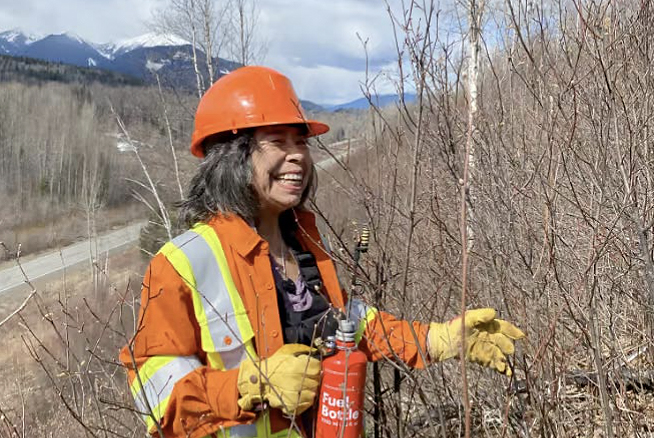Project led by Gitanyow Nation in collaboration with UBC researchers explores how cultural burning, planting practices protect against catastrophic wildfire.
Climate change, forestry and fire suppression practices have all worsened wildfire seasons in British Columbia. The worst seasons have all occurred in the last five years — more than 3.5 million hectares of forest have burned, of which two million hectares were in northern BC.
Although Indigenous fire stewardship practices were largely banned early last century, many Nations across British Columbia are returning to the practices to increase food security and restore community health and wellbeing.
Researchers from UBC Forestry are working in collaboration with the Gitanyow Nation to restore cultural fire regimes and ecosystem-based management to the territory.
Fighting Fire with Food, a three-year project funded through the Pacific Insititute for Climate Solutions (PICS), will receive $180,000 over three years.
The project explores how planting, tending, and burning fire-resistant vegetation increases the biodiversity of ecosystems, buffers against a rapidly changing climate, and protects cultural, ecological, and social values while mitigating wildfire risk.
The practice of using fire as a tool for resource management and community protection has been part of Indigenous fire stewardship for millennia.
Historically, areas surrounding important cultural sites were foodscapes managed with low-severity fire to support an abundance of berry patches, root gardens, and orchards.
“Cultural burning to me is a connection with my ancestors, a connection to the spirit world,” says Gitanyow Elder Darlene Vegh. “The smoke sends our prayers to our ancestors — it’s helping connect our DNA to the land.”
“Our ancestors spent thousands of years preparing the land to produce a symbiotic relationship to give us what we needed for food security to survive,” she says. “We spent 10,000 years preparing our table, our pantry, our food security system — and it only took 150 years for it to disappear.”
“For over 100 years, Indigenous fire stewardship techniques such as cultural burning were banned, and much of the knowledge and expertise related to burning for plants and medicines has suffered loss,” says Fighting Fire with Food researcher Dr. Kira Hoffman, postdoctoral researcher at UBC Forestry and the Bulkley Valley Research Centre.
“By returning to burning, many food systems and culturally important sites can be restored,” she says.
Plant species differ in their flammability, and when fire-resistant trees and shrubs are present, they can significantly slow down a fire or extinguish embers blown ahead of a fire front.
When these hard-to-burn species are planted in a strategic way, they can protect ecosystems as well as human life and property.
“Over the past five to 10 years, as my research team and I have reconstructed fire histories around BC and the Alberta Foothills, it has become increasingly evident that historical fire regimes across many ecosystems were strongly influenced by Indigenous fire stewardship,” says Dr. Lori Daniels, Fighting Fire with Food’s principal investigator and professor in the UBC Faculty of Forestry, Department of Forest and Conservation Sciences.
“The role of ‘good’ fire for maintaining ecosystem composition, structure, and function cannot be understated – it is essential for biodiversity and resilience to climate change,” she says.
Using fire management is fundamental to promoting core biodiversity in the landscape, according to Kevin Koch, Gitanyow Lax’yip Guardians program lead.
“Much of the landscape has been heavily impacted by direct forces, such as silviculture practices that decrease forage productivity for many species, and indirect forces related to climate change, such as extreme weather, including drought,” he says. “Burning will help increase forage values for a wide range of wildlife species which are all interconnected.”
“The biodiversity that’s there evolved over thousands of years of fire being a big part of the landscape. So when you strip away managed fire, you’re taking away habitat from the species that depended on it. “And by stripping away the managed fire, you promote extreme, catastrophic fire,” he says. “One extreme fire right now could wipe out most of the old growth in the territory.”
Read original article by Michele Mackintosh on UBC website.
